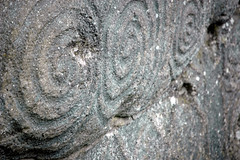What’s interesting from a grand perspective is that this is the first time you see formal territorial markers, people getting together and peeing on a chunk of land to claim it as their own.Florida State archaeologist William Parkinson commenting in Solar Circle: A 7,000-year-old henge in eastern Germany may be the world's first observatory in the July/August 2006 issue of «Archaeology» on a 7,000 year old henge that was recently excavated, reconstructed and opened to the public in Goseck, Germany.
Interesting piece if only because gives me one more pencil mark to make on my map of “cool sites I need to visit before I die”, but also because one of the sidebars is especially poignant. It reads:
After the end of WWII, German archaeologists avoided discussing the achievements of prehistoric Central Europeans because the Nazis had attempted to prove their belief in German superiority – and their war against the Jews – through the gross manipulation of archaeological evidence.Goes on to say that times, they are a changin’ – but it’s sobering to be reminded what a madman at the helm can do to throw a country off course even long after he’s gone.
For decades after the end of the war, the country’s scholars avoided fully interpreting prehistoric Central Europe culture, most especially anything that could be viewed as glorifying early Germanic people. “It was just find and label,” says University of Wisconsin-Milwaukee archaeologist Bettina Arnold. “Archaeologists would play it safe, and make catalogs, interminable catalogs, like listing and mapping all the Bronze Age shaft-hold ax heads in Central Europe.”







No comments:
Post a Comment